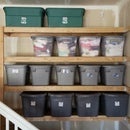Introduction: L.F.T.R. the New Age of Nuclear
Now, before an angry mob swarms to grab their torches and pitchforks, hear me out. A lot has improved technologically since the 1940's and 50's… Improvements by leaps and bounds, so don't you think it's worth an honest consideration..??
I promise, if you watch the videos I've posted, you'll find this a lot more informative.
First off, to help sort through any doubts, understand this. There are literally hundreds and maybe even a thousand different ways to do nuclear power. Some are okay, some are terrible, but a few are pretty darn good. Just like cars, for example. Of all the different car models that have been built, some are junk but others are awesome! Therefore we can’t judge them all based on one design.
In this instructable I'll focus on the better designs of nuclear power, more specifically the Liquid Fluoride Thorium Reactor (LFTR).
Step 1: Brief History:
After World War II, the U.S. government built an experimental molten salt reactor using U-233 fuel, the fissile material created by bombarding thorium with neutrons. The reactor, built at Oak Ridge National Laboratory (Oak Ridge, Tennessee), operated critical for roughly 15,000 hours from 1965 to 1969.
In 1968, Nobel laureate and discoverer of Plutonium, Glenn Seaborg, publicly announced to the Atomic Energy Commission, of which he was chairman, that the thorium-based reactor had been successfully developed and tested:
"So far the molten-salt reactor experiment has operated successfully and has earned a reputation for reliability."
During this time Alvin M. Weinberg was the administrator at Oak Ridge National Laboratory (ORNL). He innovated the first generation designs used presently in most commercial reactors. Weinberg recognized the advantages of liquid thorium over the light water reactor (LWR) designs, but received stiff opposition from the political powers in Washington. Death of the promising technology boiled down to Cold-War era politics.
Step 2: What Is LFTR?
The liquid fluoride thorium reactor (acronym LFTR; spoken as lifter) is a type of thermal breeder reactor. LFTRs use the thorium fuel cycle with a fluoride-based, molten, liquid salt for fuel. It can achieve high operating temperatures at atmospheric pressure.
Step 3: Advantages
- Inherently safe - The reaction must be driven. Otherwise it will stabilize itself out.
- Stable coolant.
- Low pressure operation - This makes it impossible to blow up.
- Leak Resistance - This is due to the low pressure operation and high freezing temperature of the liquid salt.
- No Pressure buildup due to fission - Fission products are chemically bonded to the fluoride-salt, including iodine,cesium, and strontium, capturing the radiation and preventing the spread of radioactive material to the environment.
- Easier to control - India recently announced it has completed designs for a Thorium reactor that can run for 120 days without an operator!
- Slow heatup.
- Passive decay heat cooling - Many reactor designs allow the fuel/coolant mixture to escape to a drain tank, when the reactor is not running.
- Fail safe core - LFTRs can include a freeze plug at the bottom that has to be actively cooled, usually by a small electric fan. If the cooling fails, say because of a power failure, the fan stops, the plug melts, and the fuel drains to a subcritical passively cooled storage facility.
- Less radioactive waste - LFTRs have very little structural material inside the core. Only the fuel salt, graphite, and small amounts of metals or composites are inside the actual reactor core.
- Less long lived waste - LFTRs reduce the volume of waste down to 2%. That waste also has a reduced half-life from over 100,000 years to 300 years.
- Destruction of existing long lived wastes - We can use existing radioactive waste to as fuel!
- Proliferation resistance -Bombs CANNOT be made from any of its byproducts!
Economy and efficiency:
- Thorium is very abundant - In fact, it is discarded as a waste at many rare earth mines.
- No shortage of natural resources - There are enough resources to build thousands of thorium reactors.
- Reactor efficiency - 1 ton of natural thorium in a LFTR produces as much energy as 35 t of enriched uranium in conventional reactors (requiring 250 t of natural uranium), or 4,166,000 tons of black coal in a coal power plant.
- Thermodynamic efficiency - LFTRs are 20-40% more efficient than conventional reactors.
- No enrichment and fuel element fabrication - 100% of natural thorium can be used as a fuel.
- Lower fuel cost - Fuel costs for a LFTR are approximately the same as conventional reactor but need to be replaced every 20 years as compared to every 18 months.
- LFTRs are cleaner - as a fully recycling system, most of the fission products have relatively short half lives (83% in hours or days. The remaining 17% of waste products require only 300 years until reaching background levels.
- Less fissile fuel needed - Because LFTRs are thermal spectrum reactors, they need much less fissile fuel to get started. As little as 1/8 - 1/16 as much as conventional reactors.
- No downtime for refueling - Having a liquid fuel, there is no need to shut down and take apart the reactor just to refuel it.
- Load following - As the LFTR does not have xenon poisoning, the power can be reduced in times of low demand for electricity and turn back on at any time.
- No high pressure vessel - Since the fuel is run a low pressure, all risks of explosion are eliminated.
- Excellent heat transfer - Liquid fluoride salts, especially LiF based salts, have good heat transfer properties, 22% higher than water.
- Smaller, low pressure containment - By using liquid salt as the coolant instead of pressurized water, a containment structure only slightly bigger than the reactor vessel can be used.
- Air cooling - A high temperature power cycle can be air-cooled at little loss in efficiency. This is ideal for areas where water is scarce. No need for large water cooling towers.
Efficient mining - The extraction process of thorium from the earth's crust is a much safer and efficient mining method than that of uranium.
Step 4: Disadvantages
- Mothballed technology - Only a few MSRs have actually been built. Those experimental reactors were constructed more than 40 years ago. This leads some technologists to say that it is difficult to critically assess the concept.
- Startup fuel - LFTRs require a considerable amount of U-233 for initial start up.
- Salts freezing - Fluoride salt mixtures have melting points ranging from 300 to over 600 degrees Celsius. This requires careful design and freeze protection in the containment and heat exchangers.
- Beryllium toxicity - The proposed salt mixture FLiBe, contains large amounts of beryllium, which is toxic to humans. The salt in the primary cooling loops must be isolated from workers and the environment to prevent beryllium poisoning. This is routinely done in industry.
- Loss of delayed neutrons - In order to be predictably controlled, nuclear reactors rely on delayed neutrons. They require additional slowly-evolving neutrons from fission product decay to continue the chain reaction.
- Waste management - About 83% of the radioactive waste has a half-life in hours or days, with the remaining 17% requiring 300 year storage in geologically stable confinement to reach background levels. Because some of the fission products, in their fluoride form, are highly water soluble, fluorides are less suited to long term storage. Therefore, conversion to an insoluble form would be required.
- Uncertain decommissioning costs - Cleanup of the Molten-Salt Reactor Experiment was about $130 million, for a small 8 MW(th) unit. Much of the high cost was caused by the unexpected evolution of fluorine and uranium hexafluoride from cold fuel salt in storage that ORNL did not defuel and store correctly, but this has now been taken into consideration in Multan Salt Reactor (MSR) design.
- Noble metal buildup - Some radioactive fission products, such as noble metals, deposit on pipes. Novel equipment, such as nickel-wool sponge cartridges, must be developed to filter and trap the noble metals to prevent build up.
- Limited graphite lifetime - The graphite moderator tubes have a 4 year lifespan.
- Graphite-caused positive reactivity feedback - When graphite heats up, it increases U-233 fission, causing an undesirable positive feedback.
- Limited plutonium solubility - Fluorides of plutonium, americium and curium occur as trifluorides, which means they have three fluorine atoms attached (PuF3, AmF 3,CmF 3). Such trifluorides have a limited solubility in the FLiBe carrier salt.
- Proliferation risk from protactinium separation - Compact designs can breed only using rapid separation of protactinium, a proliferation-risk, since this potentially gives access to high purity 233-U. This is difficult as the 233-U from these reactors will be contaminated with 232-U, a high gamma radiation emitter, requiring a protective hot enrichment facility.
- Proliferation of neptunium-237 - In designs utilizing a fluorinator, Np-237 appears with uranium as gaseous hexafluoride and can be easily separated using solid fluoride pellet absorption beds. No one has produced such a bomb, but Np-237's considerable fast fission cross section and low critical mass imply the possibility.
- Neutron poisoning and tritium production from lithium-6 - Lithium-6 is a strong neutron poison; using LiF with natural lithium, with its 7.5% lithium-6 content, prevents reactors from starting. Measure can be made to mitigate this issue.
- Corrosion from tellurium - The reactor makes small amounts of tellurium as a fission product. In the MSRE, this caused small amounts of corrosion at the grain boundaries of the special nickel alloy, Hastelloy-N. Metallurgical studies showed that adding 1 to 2% niobium to the Hastelloy-N alloy improves resistance to corrosion by tellurium.
- Radiation damage to nickel alloys - The standard Hastelloy N alloy was found to be embrittled by neutron radiation. Neutrons reacted with nickel to form helium. This helium gas concentrated at specific points inside the alloy, where it increased stresses. ORNL addressed this problem by adding 1-2% titanium or niobium to the Hastelloy N.
- Long term fuel salt storage - If the fluoride fuel salts are stored in solid form over many decades, radiation can cause the release of corrosive fluorine gas and uranium hexafluoride. The salts must be defueled and wastes removed before extended shutdowns and stored above 100 degrees Celsius.
- Business model - Today's solid fuelled reactor vendors make long term revenues by fuel fabrication.Without any fuel to fabricate and sell, a LFTR would adopt a different business model.
- Development of the power cycle - Developing a large helium or supercritical carbon dioxide turbine is needed for highest efficiency. These closed gas cycles face design challenges and engineering upscaling work for a commercial turbine-generator set. A standard supercritical steam turbine could be used at a small penalty in efficiency.
Step 5: The Big Picture
Despite the disadvantages, engineers at ORNL in the 1960's, were able surmount these obstacles and successfully build a thorium reactor. It operated for several years before being decommissioned in the 70's. Unfortunately Nixon's administration chose to dump this program since it would NOT produce weapons grade material.
However, in recent years there has been renewed interest in this technology by China, India, Japan, Canada, and some private companies in the US.
Interestingly many environmentalist leaders have joined this movement, recognizing that the benefits far outweigh costs.
Step 6: If You're Still Reading
I'm guessing you'd be interested in a few resources to read up on.
Here are a few links for you:
Pandora's Promise:

Participated in the
Explore Science Contest

Participated in the
MAKE ENERGY: A US-Mexico Innovation Challenge













